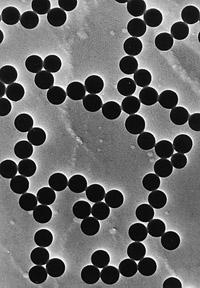Latex for biomedical applications
Through the defensive biochemical and physiological phenomena that immunology studies, a living organism distinguishes between what is natural and what is not (strange) and the latter is able to eliminate it. The immune response to antibodies produced by lymphocytes is very interesting. In order to obtain this response, substances are called antigens. Each antibody specifically knows an antigen and binds to it (immune reaction). Thus marking this strange substance, then he knows it more easily and rejects it with macrophages of the immune system of the organism.

Immunoassay sessions are based on the specific reaction between an antigen and an antibody and are the main technology used by the clinical laboratory to measure proteins, hormones, enzymes, tumor markers, drugs, drugs, etc.
The development of automated immunoanalysis is fast, simple and of high analytical sensitivity, especially to know the control and number of different analytes, in addition to having a high scientific and socioeconomic interest in the commercial demand of clinical laboratories.
Polymer colloids dispersed in water (latex particles) have a special interest in their application in the field of biomedicine, either as a support for biomolecules (proteins, enzymes,…), or for their immune response as stimulants in immune sessions. The adhesion of the antigen or antibody to the surface of latex particles produces an increase in the immune reaction due to the agglutination or aggregation of particles. The agglutination reaction along the immunosessions can be performed by optical means and facilitates the monitoring and quantification of aggregation.
Therefore, the use of latex particles as carriers of antibodies or antigens (see figure) allows to fix small concentrations of these biomolecules (ex-vivo) and to know a high number of diseases, depending on the antigen or antibody attached to the surface of the particles. This link can be physical (adsorption) or chemical (covalent bond).
On the other hand, obtaining new polymer colloids allows the development of immunological trials to achieve high analytical sensibilities while maintaining the necessary characteristics for speed and accessibility. The objective is to increase between 5 and 10 times the analytical sensitivity obtained with current methods.
Possible problems of desorption of antibodies on the surface of the latex and of unsuitable orientation to the dissolution can be solved using particles of the superficial functional group that can lead the covalent link directed to antibodies. In addition, microparticle size variability must be minimal in order to achieve reagent uniformity and ensure constant agglutination kinetics.
The physical and chemical bonding of the antibody and latex causes the loss of effective antibodies on the surface of the particle. Therefore, in order to achieve a highly sensitive procedure, it is necessary to: a) select the appropriate antibody, b) select the appropriate particle size and type, and c) optimize the reaction conditions that facilitate reactivity and avoid unspecific ligations.
This project has previously selected the particle size (0.15-0.5 mm) and its surface functionality (amino, chloromethylene, acetal, macromodem, which can lead to the covalent union of antibodies) for high analytical sensitivity.





